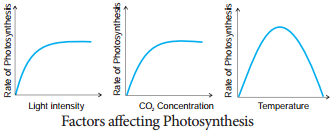Photosynthesis, the vital process by which plants convert light energy into chemical energy, plays a crucial role in their growth and survival. Various external and internal factors affect the rate of photosynthesis and determine the efficiency of food production in plants. In this article, we will explore the major factors that influence photosynthesis and understand how they affect this important biological process.
Table of Contents
7 IMPORTANT FACTORS AFFECTING PHOTOSYNTHESIS
There are many External and Internal factors which affect Photosynthesis
- Role of Light intensity and Photosynthesis
- Role of Carbon Dioxide concentration Photosynthesis
- Role of Temperature in Photosynthesis
- Role of Water in Photosynthesis
- Role of Chlorophyll in Photosynthesis
- Role of Protoplasm in Photosynthesis
- Role of Structure of Leaf in Photosynthesis
External Factors Affecting Photosynthesis
- Light intensity
- Carbon dioxide concentration
- Temperature
- Water content
1. Role of Light intensity in Photosynthesis

- Light intensity is a crucial factor that directly affects photosynthesis. As the intensity of light increases, the rate of photosynthesis also increases, reaching a maximum threshold. Beyond this threshold, other factors such as temperature or carbon dioxide concentration limit the rate of photosynthesis.
- Light provides the energy required for photosynthetic reactions to occur, making it a primary factor influencing the process.
2. Role of Carbon Dioxide concentration in Photosynthesis

- Carbon dioxide (CO2) concentration in the surrounding environment significantly impacts the rate of photosynthesis. As the concentration of CO2 increases, the rate of photosynthesis initially rises until it reaches a maximum level.
- At this point, the enzymes involved in photosynthesis become saturated with CO2 molecules, limiting further increases in the rate. Temperature and light intensity can also influence the impact of CO2 concentration on photosynthesis.
3. Role of Temperature in Photosynthesis

- As temperature increases, the rate of photosynthesis increases to a maximum and then falls.
- At higher temperatures, the molecules collide faster. This increases the rate of the chemical reactions of photosynthesis.
- But above the maximum rate, the enzymes used in photosynthesis denature (they change shape), so they can no longer catalyze reactions, and the rate of photosynthesis falls.
- With the rise in temperature, the rate of photosynthesis rises. This rise occurs up to the
- optimum temperature of 35°C (maximum suitable temperature when photosynthesis occurs best) after which the rate falls and stops above 40°C.
- At this uppermost limit, the enzymes are destroyed. A rise of 10°C up to the optimum temperature (35°C) doubles the rate of photosynthesis.
4. Role of Water in Photosynthesis
- Adequate water supply is essential for maintaining the rate of photosynthesis. Insufficient water availability, either due to reduced absorption from the soil or excessive loss through transpiration, can hamper photosynthetic efficiency.
- Water scarcity reduces the plant’s ability to intake carbon dioxide through stomata, ultimately leading to a decrease in the rate of photosynthesis.
Also Check – Where do Plants get each of the Raw Materials required for Photosynthesis
Internal Factors Affecting Photosynthesis
- Chlorophyll
- Protoplasm
- Structure of leaf
1. Role of Chlorophyll in Photosynthesis
- Chlorophyll, the primary pigment responsible for absorbing light energy during photosynthesis, plays a crucial role in this process.
- Nutrient deficiencies in minerals can lead to chlorophyll loss, which impairs the plant’s ability to efficiently trap solar energy.
- Adequate nutrient supply is necessary to maintain optimal chlorophyll levels and support robust photosynthetic activity.
2. Role of Protoplasm in Photosynthesis
- The Protoplasm, which comprises the cytoplasm and nucleus of plant cells, influences photosynthesis.
- Dehydration of the protoplasm can significantly reduce the rate of photosynthesis. Similarly, the accumulation of carbohydrates such as sugars and starches in the protoplasm can impair photosynthetic efficiency.
- Therefore, maintaining adequate water balance and carbohydrate balance is critical for optimal photosynthesis.
3. Role of Structure of Leaf in Photosynthesis
- The structure of the leaves plays a crucial role in determining the efficiency of photosynthesis.
- Factors such as cuticle thickness, stomatal distribution and leaf size directly influence the amount of light and carbon dioxide that enters the leaf.
- An optimal leaf structure ensures efficient light absorption and gas exchange, allowing photosynthesis to reach its full potential.
Also check -What are the Adaptations of leaf for Photosynthesis


9 Comments on “7 IMPORTANT FACTORS AFFECTING PHOTOSYNTHESIS”